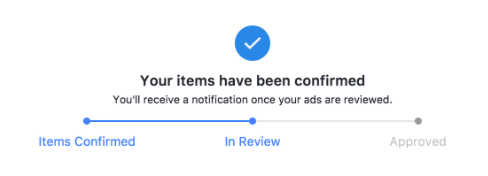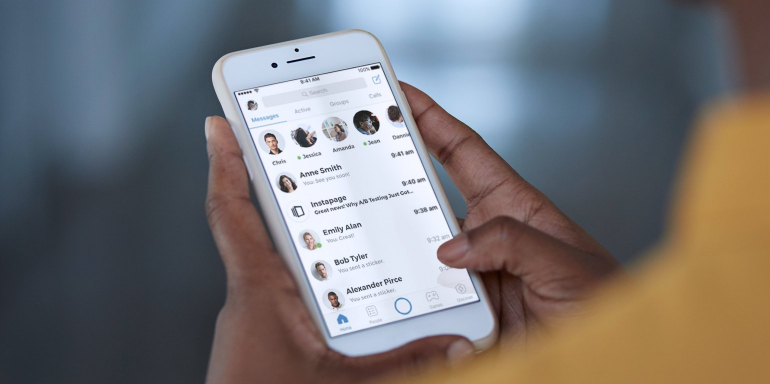In 2017, Facebook sponsored messages were released to supplement their click-to-Messenger ads. Click-to Messenger ads were (and still are) used to start conversations with prospects, while its sponsored messages now enable advertisers to easily re-engage previous conversations that may have ended without generating a lead or making a conversion.
What are sponsored messages on Facebook?
These are ads directed to target users you’ve already had a past conversation with. They’re messages sent to followers that include relevant promotions:

This ad format is ideal for any brand that has already connected with a prospect on Messenger, either through a bot or live chat support. This paid ad format is an easy, effective way to re-engage the people who currently have an open chat with your Facebook Page and to nurture those relationships by providing relevant content, promotions, and updates.
About sponsored messages Facebook ads
Sponsored messages are only labeled “Sponsored” once the chat is opened. Unlike other Messenger ads, they’re not marked as sponsored in users’ Messenger home screens, so they look like every other conversation in the list. See how the Jasper’s Market message (i.e., the sponsored message) blends in with the rest?

Along with a variety of supported objectives and call-to-action copy options, sponsored Facebook messages have certain design specs and technical requirements:
- File type: jpg or png
- Image ratio: 9:16 to 16:9
- Image size: at least 1080 x 1080 pixels
- Images that consist of more than 20% text may experience reduced delivery
- Text: 125 characters
With link:
- Images: cropped to 1.91:1
- Headline: 25 characters
- Link description: 30 characters
Technical requirements:
- Minimum image width: 254 pixels
- Minimum image height: 133 pixels
Note: The new Instapage digital advertising specs guide contains everything for every major advertising platform in one place — dimensions, file formats, examples, and more.
Tips for Facebook sponsored message images
What’s particularly unique about Sponsored Facebook messages is that they are considered image ads. That means in addition to the recommended specs and requirements above, it’s important to discuss other tips for images.
1. Show people using your product
Instead of showing the product by itself, show people using the product to make your sponsored image more compelling. Also, demonstrating how a customer could benefit from your product is more likely to intrigue them and encourage them to learn more.
2. Focus on the most important parts
Crop your image tightly around the most important piece of content. Trying to fit too much information into a single piece of media could cause viewers to pass right over it. If you have a lot of information to deliver, consider running multiple ad sets; just be sure all of your images have a consistent theme.
3. Use minimal text
Too much text is distracting and overbearing, which is why ads with higher amounts of image text are shown to fewer people. Facebook sponsored images that have minimal text (text in the description instead of directly on the ad’s image) have a much greater impact.
Here’s the difference between 0% text and 32% text (images that consist of more than 20% text may experience reduced delivery):

4. Experiment with different images
With Creative Hub, you can play around with different images, create mockups, preview your designs, and get feedback and find inspiration from other advertisers — all before running your ads.
Why should brands use Facebook sponsored messages?
Since sponsored messages can only be sent to recipients with previously-open threads; they are not flagged as spam. Another benefit to these messages is that brand awareness and interest are likely to be higher, meaning max sales and lower cost per sale.
In addition, users still have full control over blocking sponsored messages or businesses they no longer want to hear from, which demonstrates that user experience is still a top priority for Facebook.
2 success stories
Qantas
Qantas decided to test the platform to re-engage with prospects who had previously expressed interest in flying:

With their sponsored messages, Qantas made two key discoveries:
- Facebook Messenger was the most efficient digital channel for driving traffic during their spring flight sale.
- Throughout their entire five-day ad campaign, sponsored messages generated a click-through rate 4.5X higher than their Facebook link ads.
Love Your Melon
Love Your Melon, a small, charity-driven, U.S. apparel brand, used sponsored messages to re-engage customers who had previously messaged them, most of which were inquiring about shipping confirmation and details.
The message ad was used to the company’s new Melon Cap line, encouraging recipients to browse four new hat colors on their website. The ad included a lifestyle-focused image of a woman wearing one of the new Melon Caps, and a “Shop Now” CTA button directing people to the company’s website to make a purchase:

Love Your Melon’s 3-day Messenger ad campaign proved to be successful in reigniting existing conversations and promoting the new Melon Caps line, as it achieved the following impressive results:
- 14X return on ad spend
- 19% click-through rate
- $0.15 cost per click
Sponsored message best practices
1. Identify your goal
Start by choosing a clear objective for your ads: traffic, conversions, or messages. Then tailor your Messenger ad around what you hope to achieve.
To drive website traffic, for example, give them a reason to visit your site — a sale, new product, or exciting announcement are all great ways to entice people to visit. Or if you’re aiming for conversions, be very clear about what prospects are getting out of their ad click. Once they’ve clicked through, make sure they end up on a post-click landing page to convert.
2. Communicate clearly
Recipients should know immediately what you’re promoting and how your brand, product, or service can benefit them. You should also clarify any necessary instructions for prospects to take action in your greeting text.
3. Be responsive
Messenger experiences should flow similar to a typical dialogue, so it’s important that once a chat is re-engaged, businesses don’t fall silent mid-conversation. To remain active and responsive, it’s a good idea to appoint someone (even a Messenger bot) to carry out Facebook engagement. Setting up an away message to let customers know when they can expect a follow-up response can also help manage customer expectations by avoiding lags in response time.
How can you use sponsored Facebook messages?
Sponsored Facebook messages are a placement option in the Ads Manager or the Ads API. These campaigns can be refined by using interest targeting, or by creating Custom Audiences. However, to create a Custom Audience, you must have enough people who have messaged your business, with the ability to exclude certain segments based on demographics or Meta pixel events.
To send a sponsored Facebook message, you must first have a Facebook Ads account and be approved for the “ads_management,” “ads_read,” and “manage_pages permissions.” Then you can create your sponsored message ad.
How to create a sponsored Facebook message with Ads Manager
Here we’ll outline the steps in the Ads Manager:
1. Click the green Create button.
2. In the Consideration column, select the Messages objective:

It’s important to note that only one sponsored message will be delivered per person, per ad set. To deliver multiple messages per person within a single campaign, you’ll need to select “Create Multiple New Ad Sets” at the top of the Ad Set section.
3. In the Messages section, select “Sponsored Message” from the ad type drop-down plus the Facebook Page on which you’d like to run the campaign:

4. A custom audience of people who have interacted with your Page via Messenger will automatically be created. To add additional targeting to this audience, select “Show Advanced Options,” but keep in mind your audience size must be at least 20 people after setting your targeting preferences.
5. In the Placements section, select Automatic Placements (if you select Edit Placements, only “Sponsored Messages” can be selected):

6. Click “Turn On” when the placement notification appears.
7. Choose your budget and schedule. You should expect your messages to deliver in 3-5 days after your campaign starts. To manually schedule a campaign start and end date, it’s recommended to set your campaign length for at least one week to ensure full delivery.
- Budget: The minimum bid for sponsored message delivery is displayed in the Bid Strategy section. In the U.S., this bid is $30 per 1,000 impressions.
- Schedule: Keep ad scheduling set to “Run ads all the time” because sponsored messages currently do not support ads scheduling.

8. In the Message Setup section, choose either “Image & Text’ or “Text Only.”
9. Under Page & Links, select the Facebook Page you’d like your ad campaign connected to.
10. Select your desired CTA from the Call to Action list:

11. Click “Review Order” to check for errors and to ensure everything is complete.
12. Click “Place Order” to complete your ad order, and you’ll then be able to track the process your Facebook Messenger sponsored ad:

Boost conversions with Facebook sponsored messages
With Facebook sponsored message ads, brands can easily re-engage previous conversations to increase communication, drive traffic, and boost conversions.
Compelling ads are only one piece of the puzzle, though. Optimizing the post-click landing page is equally as important. To do that, you need a platform capable of providing the best end-to-end solution. The Instapage post-click optimization platform is equipped with a designer-friendly builder, team collaboration, Instablocks™, advanced analytics, and more. All of which enable you to optimize your prospects’ post-click landing page and generate maximum ROI for all your digital ad campaigns.
